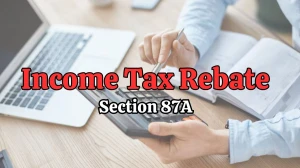
How to File DPT 3? Know the Requirements, Benefits and Applicability
Form DPT-3 also known as the “Return of Deposits,” is a vital annual filing requirement for companies in India, excluding government entities.
by Damodharan N
Published Jun 12, 2024 | Updated Jun 12, 2024 | 📖 9 min read
On This Page
How to File DPT 3?
To file DPT-3, businesses need to have registered the person responsible for the filing process based on their designation within the firm or through tax-filing audit firms in the following manner:
Login Process
- If your Manager /Secretary /Authorized Representative / Officer in default of the said firm. then they need to log in as a business user with their PAN.
- If they are directors or designated partners, then they need to log in using DIN (director identification number) or DPIN (designated partner identification number).
- If the person in charge is a company or LLP user, they need to log in with a corporate identification number (CIN) or limited liability partnership identification number (LLPIN).
- If the person filling it out is a professional who is a tax filler for an audit firm that was hired on behalf of the business, then they have to log in using the membership number and PAN.
All types of business personnel who are responsible for this filling must have a Digital Signature Certificate (DSC) for filling out the forms on the MCA website. Once they are in, users need to click the My Service portal, click the e-filing option, and choose the deposit-filling option DPT 3 to start the process.
Firm’s Details filling process
- After a successful login, users need to enter the firm details.
- Regardless of the login type, there are differing authority figures, as we discussed above. One has to choose or enter the corporate identification number (CIN). This is highly essential to fill out this form.
- Now enter the firm's basic details, like name, registered address, and email ID.
DPT-3 Related Detail Filling Process
- The "purpose of the form" option ‘Return of Deposit’ or ‘Return of Deposit and particulars of transactions by a company not considered as a deposit’ is given with only one to choose from.
- In the Next column, users need to enter whether the company is a government-owned company or not through the “Yes” or “No” radio button options. based on their answers assessed in the MCA Records database.
- The question of “Deposits being accepted from the public” will be activated if the filler chooses the ‘Return of Deposit’ or ‘Return of Deposit and Particulars of Transactions by a Company Not Considered as Deposit’ option in the “purpose of the form in S.No. 3." Now they have to enter the “Yes” or “No” radio button option.
- If the firm is private, they cannot choose the yes option.
- The next one is about the period during which the return is being filled, which is March 31st; no other date is allowed.
- This one is about the “date of advertisement or circular issued” to notify the acceptance of the Deposits Rules 2014. Which will be activated if they have chosen the ‘Return of Deposit’ or ‘Return of Deposit and Particulars of Transactions by a Company Not Considered as Deposit’ option in the “purpose of the form in S.No. 3.”
- This is mandatory if the company has entered a date that is on or after April 1st, 2014. This is optional for private companies.
- The date of expiry column option will open only if they have filled out the two options earlier, which are “purpose of the form in S.No. 3." “Date of the advertisement or circular option, which is S.No. 8” This is optional for private companies.
Deposit-Related Queries
- The “total number of deposits with the firm after the date of April 1st” for the given year is also blocked if the purpose of the form option on S.No. 3 is not filled with the earlier said options.
- The “balance of deposits outstanding at the end of the year” option is given where they have to enter the number if it applies to them based on the “purpose of form option on S.No. 3.”
- The next option is the "total number of deposit holders at the end of the financial year." This shall also be activated based on the choice given on the “purpose of the form option on S.No. 3."
- The “amount of deposits that have matured and not claimed” is the next option in the deposit-related queries in which the “purpose of the form option on S.No. 3” should be filled based on both choices given. The amount entered should be below or equal to the "balance of deposits outstanding at the end of the year,” which was earlier given.
- The next deposit query is about “the amount of deposits that have matured and claimed but not paid." Here also, filers need to do what they did for the previous column.
- The next-in-line option is also about the “Amount of deposit maturing on or before March 31st next year.” The fillers need to enter the amount that shall be below or equal to the “balance of deposits outstanding at the end of the year." The next option is the “following year option” to be filled in the same manner.
- The coming column is about the Service Request Number (SRN), which needs to be valid for the (CHG 1) Charge 1–Charge 9 (CHG 9) forms, along with the CIN (Corporate Identification Number), and also about the “Purpose of the Form,” S No. 3.
- The “date of obtaining the credit rating” from the respective agency. The date should be below the system date. And the date is also not older than 12 months from the date of filling out the form.
Attachments
- There are two mandatory options: a copy of the trust deed and a list of depositors (excel sheet). the remaining options are optional and may extend up to five options depending on the company, which include the declaration by the statutory auditor.
- In the copy trust deed fillers, they need to enter the ‘Purpose of the Form’ and SRN of CHG 1 to CHG 9 for the charge creation option. In this, each attachment shall be up to 2 MB.
- After this, the person responsible will have to give the DSC (Digital Signature Certificate) along with the login credentials that they used to login and pay the amount that was required for it after this acknowledgment email is sent.
With this, one can successfully fill the DPT-3 with much ease and navigate the tricky corporate governance of India for startups and other foreign director investors. The MCA also gave the DPT-3 form template in 2014, when the rules were notified, which can be accessed by clicking this link here.
DPT 3 Requirements
The DPT 3 return of deposits requires the number of things that the firm has to give before they start the filling process. These include
- An active CIN (Corporate Identification Number)
- An active GLN (Global Location Number)
- DIN (Director Identification Number)
- DPIN (designated partner identification number)
- LLPIN (Limited Liability Partnership Identification Number)
- PAN (Permanent Account Number)
- Statutory Auditor Certificate
- Credit Rating
- Trust deed
- SRN (Service Request Number)
- Active DSC (Digital Signature Certificate)
These are some of the numbers and documents one needs to fill out the DPT-3 process.
DPT 3 Applicability
The DPT 3 is applied to all companies, except the government company and other firms that deal with deposits and are under RBI regulation.
Applicable firms
Companies Act 2013 Section 8 firms that deal in the area of promotion of
- Commerce,
- Art,
- Science,
- Sports,
- Education,
- Research,
- Social Welfare,
- Religion,
- Charity,
- Protection of the Environment, or
- Any similar objectives.
These can be foundations and NPOs (non-profit organizations), among others. These private firms are also applicable to those who deal in any of the given areas. The conversion of a one-person company's OPC to first limited liability and then to a section 8 company is possible as per the law provided.
From this, we can see that the deposits from public options make sense. As there are firms that might include civil society groups and pressure groups like the Chamber of Commerce, The scale of the authority reaches a new peak. Read this in conjunction with the FEMA Act of the Parliament of India to get an overall big picture.
Exempted firms
The exempted firms are
- Government firms
- Banking Company
- Non-Banking Financial Companies (NBDC) registered with the RBI
- Housing Finance Company (HFC)
The role of these institutions is primarily about deposit collection from the public, and the oversight body for them is the Ministry of Finance, CAG (comptroller auditor and general), and RBI. They don't need to be burdened with MCA compliance; that's the reason they are excluded from this compliance.
What is the Role of E-Governance in Easing the Corporate Compliance Norms?
The role of e-governance in easing corporate compliance is really new to India, but it was started in the 1970s with the formation of the Department of Electronics. and later the National Informatics Center in 1977.
There was lackluster growth till 1980, and after the IT boom started picking up, that coincided with LPG reforms in 1991. This led to the growth of digital governance in India and then picked up the pace after 2014, with more service being given by the state machinery digitally and improving the compliance norm.
A case in point is e-filling, which improved the tax leakage problem and brought transparency. Nowadays, even the local municipal corporation issues certificates of compliance digitally with DSC, thereby reducing the time and money spent on getting a single complaint form.
So this e-governance, or digital governance, as it is called, is trying to reduce the interface with government machinery called bureaucrats with their own interests rather than a screen interface called a website, which does its job if you have all the documents that are required.
Benefits of DPT 3 in Corporate Governance
- The Benefits of DPT 3 in Corporate Governance are about bringing transparency to the deposits that the public gives for public causes like NGOs, research, social welfare, Chambers of Commerce, and foundations, among others.
- The data they enter will be used in a manner of good faith to have public oversight over how they are spending the money via ROC (Registrar of Companies).
- DPT-3 was bought in because the big private firms use the “foundation route” and are not taxed for the profit they make, escaping the highly taxed corporate polity in the world.
- Even though this was bought in good faith, there was a "fait accompli" issue, meaning the small foundations and budding foundations that work in public welfare have to bear this burden for the fault of big corporate firms.
- This gives the government of the day incredible oversight over public spending by these types of organizations.
- This helped plug tax loopholes in corporate tax governance in Indian polity.
How to File DPT 3 - FAQs
1. What is DPT-3?
DPT-3 is a form required to be filed by companies to report deposits and transactions that are not considered deposits.
2. Who needs to file DPT-3?
All companies, except government firms, banking companies, NBFCs registered with RBI, and housing finance companies, need to file DPT-3.
3. What information is required to file DPT-3?
You need the CIN, PAN, DSC, and other company details like name, registered address, and email ID.
4. Why is filing DPT-3 beneficial for corporate governance?
It ensures transparency in the handling of public deposits and helps plug tax loopholes, enhancing oversight and accountability.
5. Where can I find the DPT-3 form?
The DPT-3 form can be downloaded from the MCA website.




